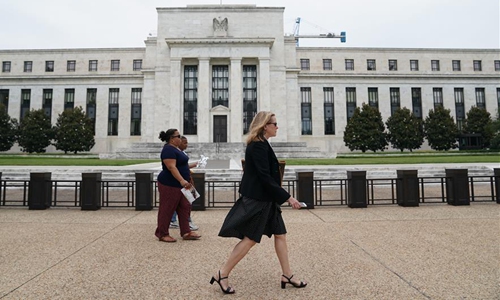US Fed cuts rates to near zero amid coronavirus fears
Source:Xinhua Published: 2020/3/16 5:31:35

People pass by the US Federal Reserve building in Washington D.C., the United States, June 5, 2019. File Photo: Xinhua
The US Federal Reserve on Sunday cut its benchmark interest rate by a full percentage point to near zero and pledged to increase its bond holdings by at least 700 billion US dollars amid mounting fears over the coronavirus outbreak.
"The coronavirus outbreak has harmed communities and disrupted economic activity in many countries, including the United States," the Fed said Sunday afternoon in a statement, adding global financial conditions have also been "significantly affected."
The central bank noted that the effects of the coronavirus will "weigh on" US economic activity in the near term and pose risks to the economic outlook. Therefore, the Federal Open Market Committee (FOMC), the Fed's policy-making committee, decided to lower the target range for the federal funds rate to 0-0.25 percent.
"The Committee expects to maintain this target range until it is confident that the economy has weathered recent events and is on track to achieve its maximum employment and price stability goals," said the Fed.
The Fed also said that it will increase its holdings of Treasury securities by at least 500 billion dollars and its holdings of agency mortgage-backed securities by at least 200 billion dollars over coming months.
"The Federal Reserve is prepared to use its full range of tools to support the flow of credit to households and businesses and thereby promote its maximum employment and price stability goals," the central bank said.
The Fed's latest action came less than two weeks after it slashed rates by a half percentage point in an emergency move that failed to reassure nervous investors.
It also marked the Fed's unprecedented second emergency rate cut since the 2008 financial crisis, as the central bank is scheduled to hold its next policy meeting on Tuesday and Wednesday.
Diane Swonk, chief economist at Grant Thornton, a major accounting firm, said the Fed's latest action is "so important" and will help ease credit market conditions.
"The key is to keep companies and consumer sideswiped by a health crisis afloat and solvent in #COVID19-tainted waters," Swonk tweeted Sunday. "This isn't a banking crisis -- it is a health crisis that we can prevent from militating into a financial crisis."
The United States reported 3,244 COVID-19 cases as of Sunday afternoon with at least 62 deaths, according to the Center for Systems Science and Engineering at Johns Hopkins University.
Economists are predicting that the US economy will contract in the second quarter amid mounting fears about the economic impact of the global spread of the coronavirus.
About 55 business and academic economists recently polled by The Wall Street Journal expect, on average, US gross domestic product (GDP) to contract at an annual rate of 0.1 percent in the second quarter due to the epidemic.
That is a large downgrade from forecasts in February, when those economists expected US GDP growth of 1.9 percent from April to June, the poll showed.
Ryan Sweet, an economist with Moody's Analytics, said the path the US economy heads down could be "darker" than their baseline forecast because of the coronavirus and the uncertainty surrounding the fiscal policy response.
"In our pandemic scenario, the US economy contracts in all four quarters of 2020, with real GDP falling by approximately 1.5 percentage points peak to trough and the unemployment rate rising by 175 basis points," Sweet wrote Thursday in a report.
The Fed on Sunday also announced a series of steps to boost lending, including by lowering the rate charged to banks for short-term emergency loans from its discount window to 0.25 percent from 1.75 percent.
In a global coordinated move by major central banks, the Fed said Sunday in a separate statement that the Bank of Canada, the Bank of England, the Bank of Japan, the European Central Bank, the Federal Reserve, and the Swiss National Bank took action to enhance US dollar liquidity around the world through existing dollar swap line arrangements.
"These central banks have agreed to lower the pricing on the standing US dollar liquidity swap arrangements by 25 basis points, so that the new rate will be the US dollar overnight index swap (OIS) rate plus 25 basis points," the statement said.
The swap lines are available standing facilities and serve as an important liquidity backstop to ease strains in global funding markets, thereby helping to mitigate the effects of such strains on the supply of credit to households and businesses, according to the statement.